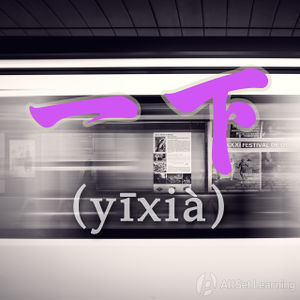Difference between revisions of "Verbing briefly with "yixia""
(→Books) |
|||
| Line 38: | Line 38: | ||
* [[Integrated Chinese: Level 1, Part 1 (3rd ed)]] (pp. 126) [http://www.amazon.com/gp/product/0887276385/ref=as_li_ss_tl?ie=UTF8&tag=allset-20&linkCode=as2&camp=217145&creative=399369&creativeASIN=0887276385 →buy] | * [[Integrated Chinese: Level 1, Part 1 (3rd ed)]] (pp. 126) [http://www.amazon.com/gp/product/0887276385/ref=as_li_ss_tl?ie=UTF8&tag=allset-20&linkCode=as2&camp=217145&creative=399369&creativeASIN=0887276385 →buy] | ||
| + | *[[40 Lessons for Basic Chinese Course (基础汉语40课上册)]] (p. 206)[http://www.amazon.com/gp/product/B001FTL8D8/ref=as_li_ss_tl?ie=UTF8&camp=1789&creative=390957&creativeASIN=B001FTL8D8&linkCode=as2&tag=allset-20 →buy] | ||
[[Category:A1 grammar points]] | [[Category:A1 grammar points]] | ||
Revision as of 06:01, 8 July 2013
-
Level
-
Similar to
-
Used for
-
Keywords
Use 一下 (yīxià) to express a brief action.
Structure
To express that a verb is carried out briefly or "a little bit," you can add 一下 after it.
The structure is:
Subject + Verb + 一下 + Object
Examples
- 你 看 一下。Take a quick look.
- 请 你 读 一下。Can you please read a bit of it.
- 我 听 一下 音乐。I'll listen to some music.
- 你 尝 一下 这 个 菜。Have a little taste of this dish.
Often, adding 一下 just makes the Chinese feel more natural. This is not something you can get a feel for quickly. You'll want to observe how native speakers use 一下 over a long period of time to really get used to how it is used.



